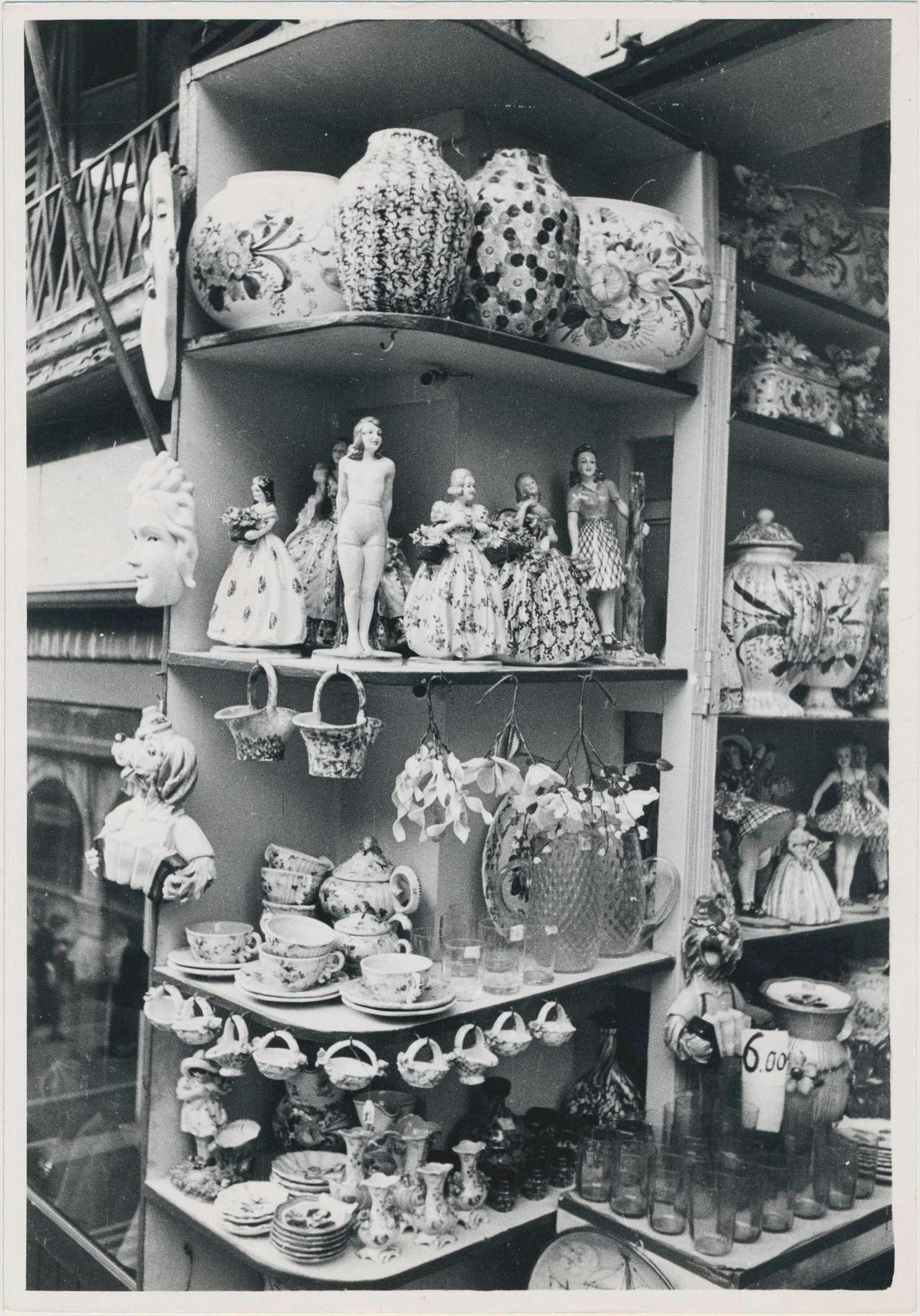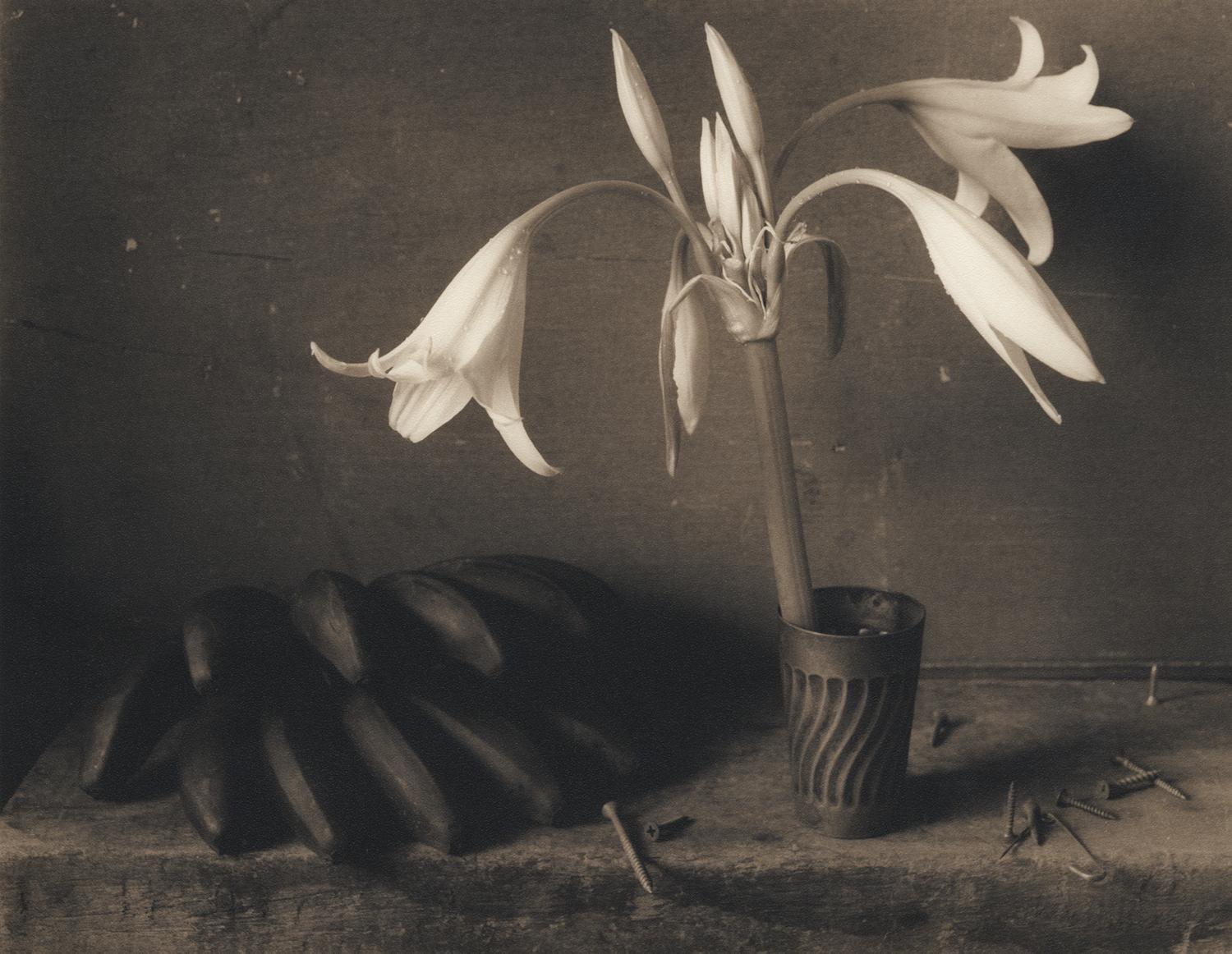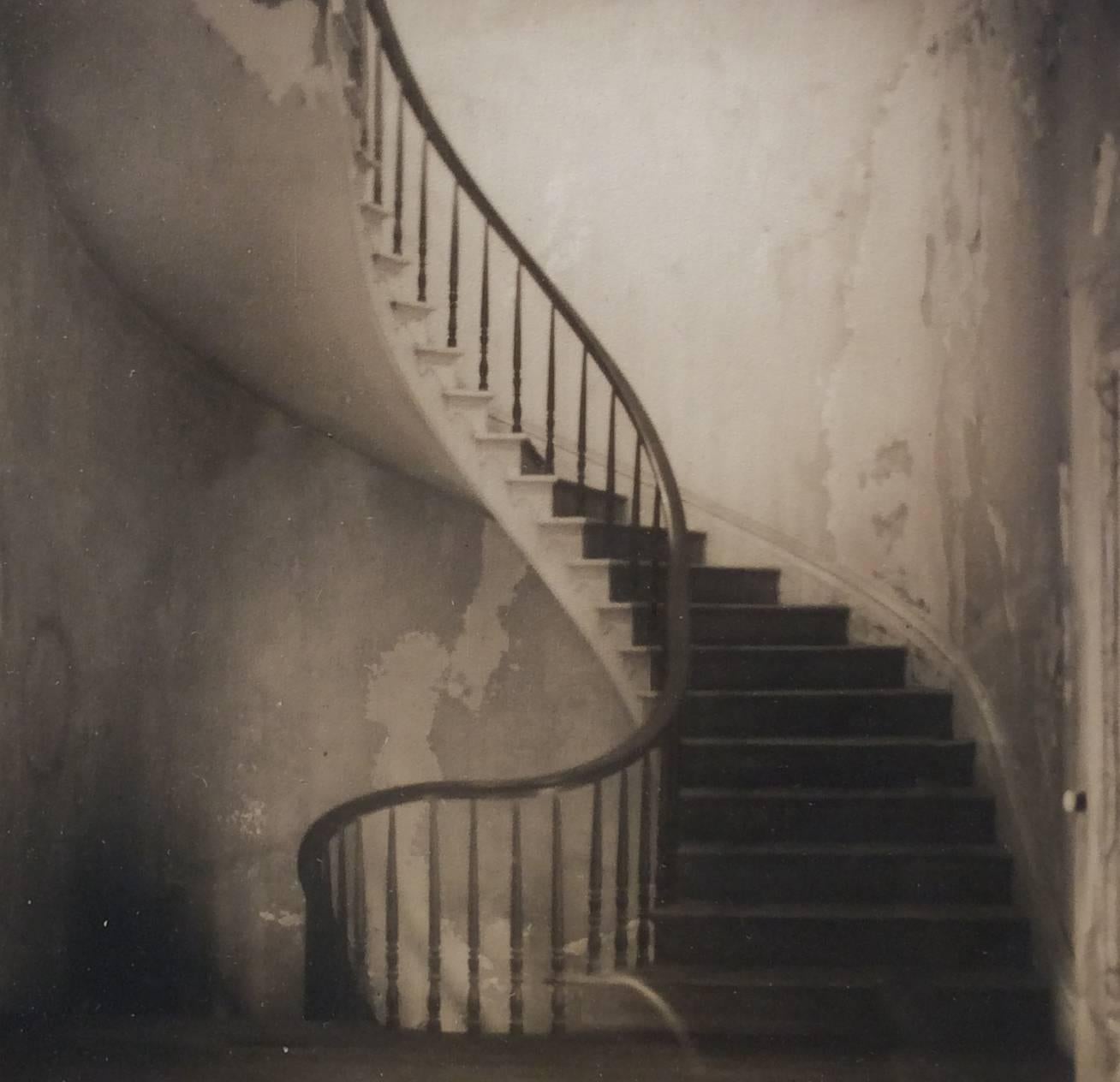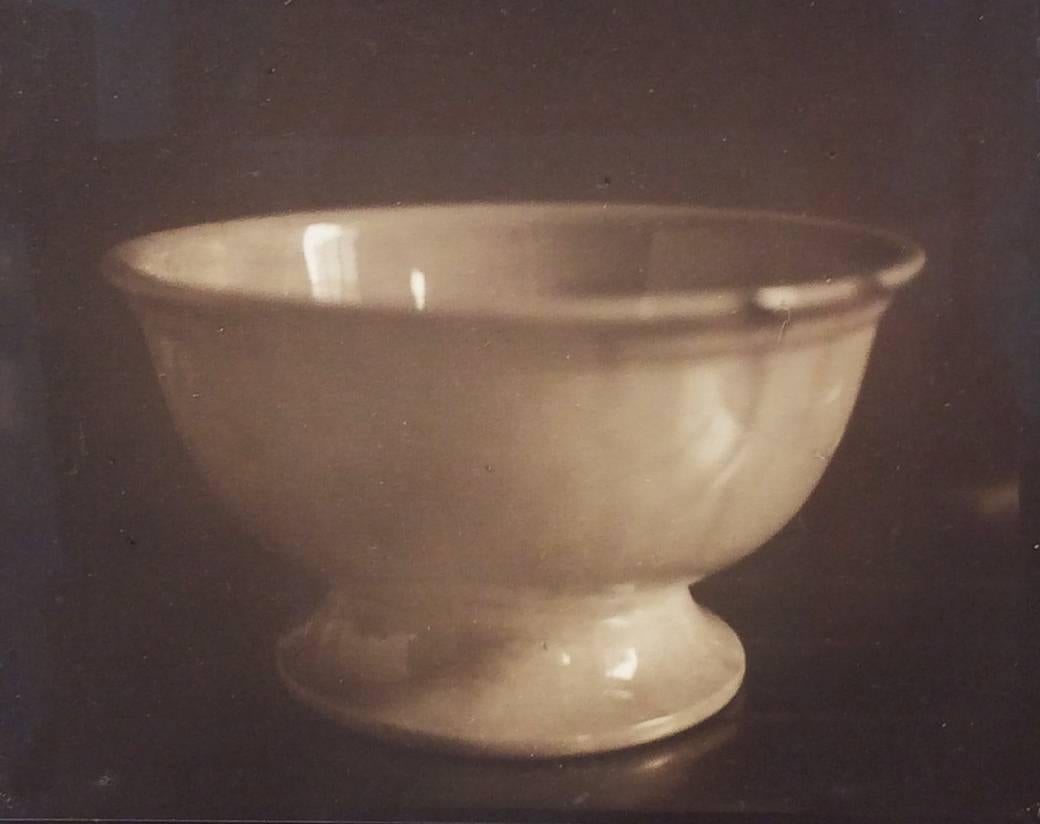Items Similar to Shell (Black & White Still Life Photograph of a White Shell, Framed)
Want more images or videos?
Request additional images or videos from the seller
1 of 11
David HallidayShell (Black & White Still Life Photograph of a White Shell, Framed)2003
2003
About the Item
Black and white still life photograph of a white shell on a simple white background
"Shell", photographed by David Halliday in 2003
Sepia toned silver gelatin print, ed. 14/25
19 x 23.5 inches, 25 x 30.25 inches in a custom, white painted wood frame
Excellent condition, ready to hang as is
"Shell" is a framed still life, sepia toned silver print by photographer, David Halliday. The artist focuses on subtle transitions of light and shadow against the simplistic curvature of the white shell. The resting object is photographed against a white background, creating an ethereal and atmospheric affect. The framed still life photo is complemented with a white painted wood frame. It's in excellent condition and ready to hang as is.
About the work:
The designation “still life” implicitly suggests one of the goals of both painters and photographers dedicated to the genre: they want to imbue the inanimate objects they depict with the vibrancy of life despite the immobility of the medium. Like the great painters of still life—Zurbarán, Chardin, Cézanne, Morandi—Halliday charges his fruits, vegetables, and other objects with a poised intensity that intrigues us partly because possible meanings are just out of reach.
David Halliday reaches into his archives of images to compile a selection of both sepia toned photographs mixed with more recent color works; each are iconic representations of the most ordinary objects of everyday life. Together they represent a fading essence of things quintessentially ‘American’. For the artist, beauty and nostalgia are pervasive, but lamentation has its role as well.
About the artist:
David Halliday first gained renown for his sepia-toned silver prints of elegant, meticulously-composed still lifes. His more recent color work maintains the same intimate and simple beauty but also creates a visceral connection for the viewer. Like a painter, he emphasizes volumes, balances, texture and areas of subtle shading. David Halliday sets himself apart from the bulk of contemporary photographic practice in several ways. Along with Aaron Rose and Sally Mann, he is one of the art photographers to have resisted adopting the new digital technology that produces instant color images. He develops his silver gelatin prints by hand, and his only technical departure from the standard black-and-white approach is to tone his pictures with sepia. Doing so connects him with the Photo-Secession movement launched by Alfred Stieglitz just over a century ago, when, in a different context, photographers with serious artistic goals tried to distinguish their work from aesthetically deficient examples of photography dominating the market in that day. Stieglitz’s associates were also trying to equal or surpass the quality of turn-of-the-century painting, which, in 1905, meant avoiding the documentary, signboard realism characteristic of most non-portrait photography of the era immediately preceding them. They wanted to prove that photography was indeed an art, and that its images could embody qualities of design and subtle evocation as successfully as Impressionist painting did.
As painting underwent and reflected the political and technological shocks of the 20th century, art photography, too, moved away from the Photo-Secessionist ideal toward something more startling and abrasive, often serving social causes by documenting human suffering in various parts of the globe. Surrealist photographers stage-managed and manipulated their pictures so as to produce imagery that seemed to belong to the uncanny arena of dreams or nightmares. Halliday, though he recalls the meditative refinement of the Photo-Secessionists, has drawn as well on Surrealist aesthetics to arrive at his imagery.
Born in Glen Cove, New York in 1958, Halliday attended Syracuse University and pursued further studies under the tutelage of Arnold Newman. He has exhibited widely in solo and group exhibitions throughout the United States and Europe. In 2002, the Contemporary Arts Center in New Orleans exhibited a retrospective of his work and in 2012, he exhibited at the Ogden Museum of Southern Art, New Orleans. Halliday’s work is included in numerous public and private collections including the New Orleans Museum of Art; the Museum of Fine Arts, Houston, and the New Britain Museum of Art.
- Creator:David Halliday (1958, American)
- Creation Year:2003
- Dimensions:Height: 25 in (63.5 cm)Width: 30.25 in (76.84 cm)Depth: 2 in (5.08 cm)
- Medium:
- Movement & Style:
- Period:
- Condition:
- Gallery Location:Hudson, NY
- Reference Number:1stDibs: LU2277185922
About the Seller
5.0
Platinum Seller
These expertly vetted sellers are 1stDibs' most experienced sellers and are rated highest by our customers.
Established in 1991
1stDibs seller since 2013
543 sales on 1stDibs
Typical response time: 2 hours
- ShippingRetrieving quote...Ships From: Hudson, NY
- Return PolicyA return for this item may be initiated within 3 days of delivery.
More From This SellerView All
- Lilies & Plantains: Sepia Toned Still Life Photograph of Flowers and FruitBy David HallidayLocated in Hudson, NYFormalist sepia toned still life photograph of white lily flowers and brown plantains on a tabletop Lilies and Plantains, by David Halliday, printed in 2003 Sepia toned silver gelati...Category
Early 2000s Modern Still-life Photography
MaterialsSilver Gelatin
- Staircase (Square, Sepia Toned Vintage Photograph of a Spiral Staircase)By David HallidayLocated in Hudson, NYSepia toned silver gelatin print, edition 4 of 25 Custom black stained wood molding with visible grain 8-ply antique white mat with AR non glare glass. 4.5 x 4.5 inches unframed, 17 x 17 inches framed This square sepia toned silver gelatin print of a Victorian spiraling staircase...Category
1990s Modern Still-life Photography
MaterialsSilver Gelatin
- Magnolia Leaf (Framed Sepia Toned Still Life Photograph of Single Leaf)By David HallidayLocated in Hudson, NYFramed still life photograph of single magnolia leaf Sepia toned silver gelatin print, vintage uneditioned print Custom black stained wood molding with visible grain 8-ply antique w...Category
1990s Modern Still-life Photography
MaterialsSilver Gelatin
- Stoneware Bowl (Small Sepia Toned Still Life Photograph of White Ceramic Bowl)By David HallidayLocated in Hudson, NYVintage style still life photograph of antique white bowl, framed Sepia toned silver gelatin print, vintage uneditioned print Custom black stained wood molding with visible grain 8-...Category
1990s Modern Still-life Photography
MaterialsSilver Gelatin
- Candle Stand (Sepia Toned Still Life of Side Table in Vintage Frame)By David HallidayLocated in Hudson, NYCandle Stand, 2017 15" X 12" framed sepia toned silver gelatin print This vertical sepia toned silver gelatin print still life of a candle stand was captured by photographer, David...Category
2010s Contemporary Still-life Photography
MaterialsArchival Paper, Silver Gelatin
- Still Life with Cushaw (Sepia Toned Still Life Photograph of Vegetable, Framed)By David HallidayLocated in Hudson, NYContemporary still life sepia toned photograph of cushaw squash, black cherries, and banana vines on a tabletop by David Halliday Sepia toned silver gelatin print, edition 1 of 25 17...Category
1990s Contemporary Still-life Photography
MaterialsSilver Gelatin
You May Also Like
- Venice, Shop, Street Photography, Black and White, Italy 1950s, 17, 8 x 12, 4 cmBy Erich AndresLocated in Cologne, DESilver Gelatine Print by Erich Andres, ca 1950. Andres was born 1905 in Germany and passed away 1992. He started his career as a photographer in 1920. He was one of the first photogr...Category
1950s Modern Black and White Photography
MaterialsBlack and White, Silver Gelatin
- Pottery, Shop, Street Photography, Black and White, Italy 1950s, 17.8 x 12.4 cmBy Erich AndresLocated in Cologne, DESilver Gelatine Print by Erich Andres, ca 1950. Andres was born 1905 in Germany and passed away 1992. He started his career as a photographer in 1920. He was one of the first photogr...Category
1950s Modern Black and White Photography
MaterialsBlack and White, Silver Gelatin
- Sewing SilkLocated in Dallas, TXEdition of 33 Signed in pencil on verso. Bauhaus II PortfolioCategory
1930s Modern Black and White Photography
MaterialsSilver Gelatin
- 'The Three Graces' Oversize V&A Portfolio Limited Edition printBy Antonio CanovaLocated in London, GBDetail of The Three Graces, Antonio Canova (1757-1822), National Collection of Sculpture, Victoria and Albert Museum © Victoria and Albert Museum, London Beautiful Extra Large 40 x ...Category
1810s Modern Still-life Photography
MaterialsSilver Gelatin
- 'Neptune' V&A Portfolio Limited Edition printBy Gian Lorenzo BerniniLocated in London, GBDetail of Neptune’s Head, Neptune and Triton, Gian Lorenzo Bernini (1598-1680), National Collection of Sculpture, Victoria and Albert Museum © Victoria and Albert Museum, London Pho...Category
1620s Modern Still-life Photography
MaterialsSilver Gelatin
- Photo Of Pedro Friedeberg Hand Chair Vintage Silver Gelatin PhotographBy Naomi SavageLocated in Surfside, FLThis depicts a chair in the manner of Mexican surrealist modernist Pedro Friedeberg with a dried flowers. It is a hand signed, titled and dated vintage silver gelatin print photograph. and bears the artists studio stamp verso. Naomi Siegler Savage (1927 – 2005) was an American woman photographer. A native of Princeton, New Jersey, Naomi Savage was the niece of artist Man Ray. She first studied photography under Berenice Abbott at the New School for Social Research in 1943, following this with studies in art, photography, and music at Bennington College from 1944 until 1947. The next year she spent in California with her uncle, studying his techniques. When she returned to New York in 1948, she combined her love of music with her skill in photography by taking portraits of the best known composers of day: Aaron Copland, John Cage, Virgil Thomson, etc. (over 30 in all). In 1950 she married the architect and sculptor David Savage, with whom she moved to Paris, living there for some years. During her career Savage received an award from the Cassandra Foundation in 1970, and a photography fellowship from the National Endowment for the Arts in 1971. In 1976 she received the silver award from the Art Directors Club. Later in life, Savage returned to live in Princeton, where she died. Savage was heavily influenced by her uncle, the avant garde artist Man Ray, prompting her to experiment with the medium of photography, combining traditional techniques with more unusual processes, including some of her own design. She worked extensively with photogravure and photoengraving, transforming these mechanical printing techniques to be used for aesthetic effects rather than duplication. Unlike many photographers, Savage considered the metal plate that photographs are etched on to be a work of art in its own right. She pioneered the use of using the photographic metal plate to produce a three dimensional form with a metallic surface. Savage explored variations in color and texture in her work often by using inked and intaglio relief prints. Many of her works were created by combining media such as collage, negative images, texture screening, multiple exposure, photograms, solarization, toning, laser printing on metallic foils. Her works focus on a variety of subject matter and imagery, which has included portraits, landscapes, human figures, mannequins, masks, toys, kitchen utensils, dental and ophthalmological equipment. Her approach represents an involvement with "process as medium," and an interest in art as image manipulation, a pursuit shared by contemporaries like Robert Heinecken, Betty Hahn, and Bea Nettles. She has experimented extensively with photogravure and photoengraving, employing these mechanical printing techniques for aesthetic effects rather than duplication. Savage uses inked and intaglio relief prints to explore variations in color and texture, and considers the metal plate on which the photograph has been etched to be a work of art in its own right. She has also combined media--collage, negative images, texture screening, multiple exposure, photograms, solarization, toning, printing on metallic foils--and made laser color prints. Several of her pieces are owned by the Museum of Modern Art, and she is represented as well in the collections of the Art Institute of Chicago, the International Center for Photography, the Fogg Art Museum, the Museum of Fine Arts, Houston, and the Madison Art Center. A photo engraved mural depicting the life of Lyndon Baines Johnson is a centerpiece of the Lyndon Baines Johnson Library and Museum. A collection of her papers relating to the life of Man Ray is held by the Archives of American Art at the Smithsonian Institution. She was included in the show Making Space at MoMA in 2017. It shone a spotlight on the stunning achievements of women artists between the end of World War II (1945) and by Lee Krasner, Helen Frankenthaler, and Joan Mitchell; the radical geometries by Lygia Clark, Lygia Pape, and Gego; and the reductive abstractions of Agnes Martin, Anne Truitt, and Jo Baer; the fiber weavings of Magdalena Abakanowicz, Sheila Hicks, and Lenore Tawney; and the process-oriented sculptures of Lee Bontecou, Louise Bourgeois, and Eva Hesse. The exhibition also featured treasures such as collages by Anne Ryan, photographs by Gertrudes Altschul, Naomi Savage, Ruth Asawa, Carol Rama...Category
1980s Modern Black and White Photography
MaterialsSilver Gelatin
Recently Viewed
View AllMore Ways To Browse
Framed Shell
Shell In Frame
Lighted Shell
White Shell Light
Framed Shell Prints
Black And White Fruits
Sepia Set
Painter Chardin
Secessionist Silver
Secessionist Wood
Secessionist Frame
David Mann
David Mann Art
Secessionist Print
Shell Cove
Native American Vintage Native American
Abstract Sculptures Medium
Sculpture 50





